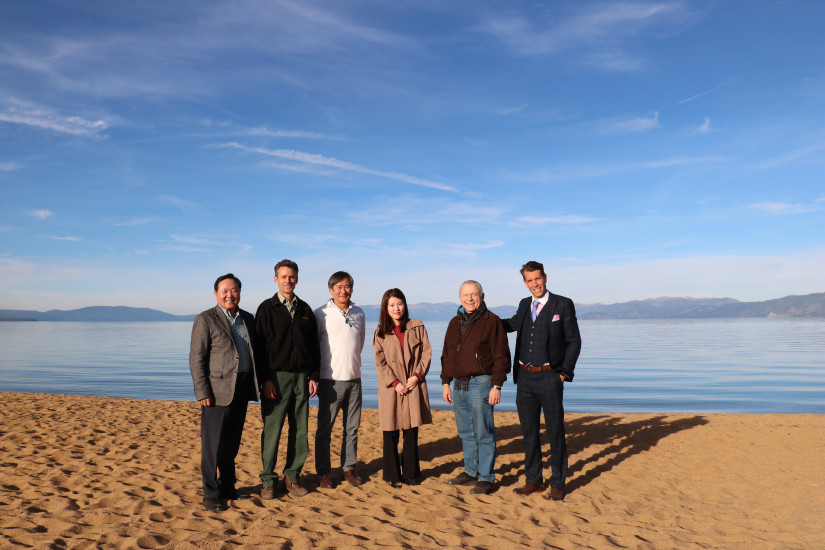Dorian Fougères is the Chief of Natural Resources at the California Tahoe Conservancy and was a 2007 California Sea Grant State Fellow with the CALFED Science Program – now the Delta Stewardship Council (and Delta Science Program). He is passionate about stewarding natural resources, especially now, in the face of climate change and the many stressors that our natural environment faces.
Can you explain what your current role as the Chief of Natural Resources at the California Tahoe Conservancy looks like?
I oversee all of our resource management programs: 6,500 acres in the Lake Tahoe Basin,11 recreational facilities plus six public beaches around Lake Tahoe, a variety of landscape-scale forest and watershed restoration programs, and our Climate Action Adaptation Plan.
Within the Lake Tahoe Basin, I also sit on several coordinating committees to help align the work of different agencies, and spend about a quarter of my time in Sacramento making linkages between state policy and what we're doing here in Tahoe, particularly around forestry, sustainable communities, and climate adaptation.

Why is this work important to you?
On a personal level, I'm most passionate about stewarding our natural resources, and very concerned about how much climate change will transform our world.
Professionally, it is a lot of fun to work in Tahoe because it's bigger than a large city, but it's not a very large region. The ability to make tangible change is very high – you can see the results of different programs and projects. It is also one of several parts of the state where there is visionary leadership and an opportunity to be a model for management and restoration programs that can be translated to other areas in California.
The model piece is particularly interesting because Tahoe has the same extraordinary resources as any national park, in addition to more annual visitors (29 million), and 60,000 residents. If we can dynamically manage and maintain the resilience and health of our landscapes and communities at the same time, then we can be an example to other parts of the state.
How has this region remained pristine despite resource depletion and high numbers of visitors throughout the year?
I think there's two general reasons.
The first is early recognition, particularly in the 1960’s, of the significance and unique value of Lake Tahoe – in terms of it being an alpine lake and the second deepest in the United States. All of which has led to a slew of environmental protection regulations.
The second reason – fast forward to 1997 – involves the first presidential summit held in Lake Tahoe by Bill Clinton and Al Gore. This summit launched the Basin-wide Environmental Improvement Program, a partnership of about 80 different agencies dedicated to protect and restore Lake Tahoe. This is an all-encompassing program for resource protection and restoration and is a critical reason why Tahoe remains in good shape.
What do you think are the biggest hurdles the Conservancy faces?
The biggest challenge we face is sustained funding.
We rely heavily upon voter-approved bond funding, meaning that we obtain a large chunk of money every so often. We got $27 million from Proposition 68 last year, which provides money to keep projects running, and to supply grants. However, when this funding runs out, as it inevitably does, then we have to shrink programs and are unable to support our partners. It’s like a roller coaster – a boom and bust cycle – which is not an optimal way to manage resources.
In an ideal world, there would be broader public recognition and willingness to create dedicated funding for resource management. If people received some sort of dividend, like utility rebates, people would see more tangible benefits of a fee or tax.
What are some of the greatest accomplishments you have had with the conservancy?
I led the updating and writing of our new strategic plan, helped improve our internal organizational systems, and helped staff become familiar with stakeholder engagement and negotiation processes.
The second is supporting our forest restoration efforts like the Lake Tahoe West Restoration Partnership, which is extremely innovative. Another includes helping launch our very integrated Climate Adaptation Action Plan, which will be done by the end of the year, and incorporates all of the Lake Tahoe resorts, forest resources, and community components such as physical and mental health and cultural resources.
How you feel the California Sea Grant State Fellowship shaped your career trajectory?
I was placed with the CALFED Science Program in Sacramento, an innovative department that linked federal and state agencies to better manage the Sacramento-San Joaquin River Delta, which provides water to the San Joaquin Valley, Bay Area, and Southern California.
This fellowship helped me transition from marine resource management to freshwater related issues, and really set me on a different path. It introduced me to Sacramento and the statewide policy issues directed at water resources at large. There I launched my career as a public policy mediator for the next eight years. So, it distinctively shaped the type of environments in which I worked, and led to some serendipitous professional connections that steered my career to where I am today.
Do you have any advice for current or future fellows?
- Use this opportunity to gain exposure to a variety of different professional careers.
- Build your network because you do have status and significance that allows you to introduce yourself to many people in various professions.
- Be bold, and be ambitious. Incremental changes are not going to get us where we need to be in terms of our relationship with the environment.
“Anything you can do, or dream you do, begin it: boldness has genius, power, and magic in it.”
- Johann Wolfgang von Goethe
Interview conducted by Tayler Tharaldson, California Sea Grant Science Communication Fellow